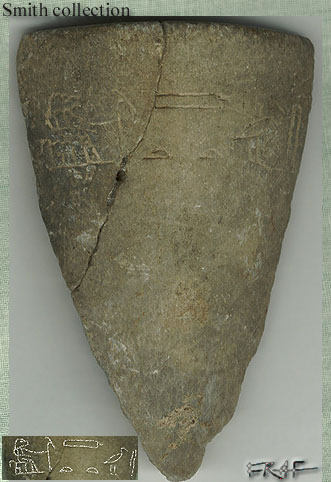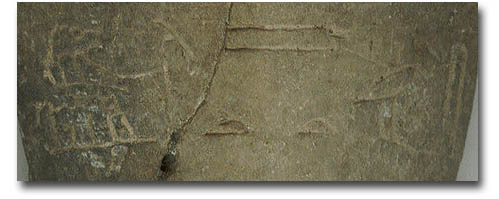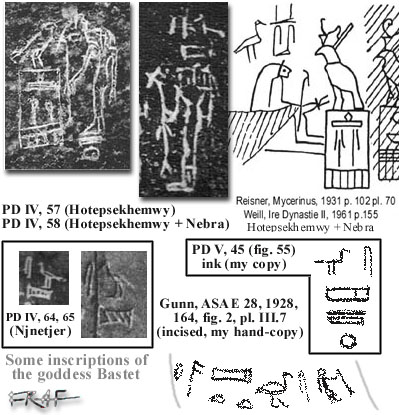 This is a fragment of an Early Dynastic stone vessel in the private
Smith collection (USA) inscribed with the name of the goddess Bastet
(Wbastit). The object is made of two sherds joined together; the inscription
is incised, with no sign of pigments in the lines; the goddess name
is complete but it cannot be said if the inscription is too. The fragment
max size is 2.5 x 1.75 inches (6,35 x 4,45cm) and it seems that it
was originally a small roughly conical vessel of a grey
stone; its lip is carefully rounded.
This is a fragment of an Early Dynastic stone vessel in the private
Smith collection (USA) inscribed with the name of the goddess Bastet
(Wbastit). The object is made of two sherds joined together; the inscription
is incised, with no sign of pigments in the lines; the goddess name
is complete but it cannot be said if the inscription is too. The fragment
max size is 2.5 x 1.75 inches (6,35 x 4,45cm) and it seems that it
was originally a small roughly conical vessel of a grey
stone; its lip is carefully rounded.
THE INSCRIPTION
The name of the lion (later cat-) goddess Bastet is rather common
in the Second Dynasty (cf. image below, especially from Hotepsekhemwy
and Ninetjer reigns): the w
is always graphically elided because initial atone vowel which usually
doesn't appear in the writing (except in the Greek rendering i.e.
the name of king Petubastit = Petubastis; Lacau, in: PD V, 35). The
s precedes the Ba bird owing to a common graphical metathesis
recurring in most of the variants of this name. The horizontal ointment
vessel bas is very stylized, unusually long and without
inner lines but only the indication of the lid. The two t
of the radical and feminine ending are often elided in the archaic
writing, but they are retained in the present one. The determinative
of the sitting goddess is attested in Early Dynastic inscriptions
as the name also is. The goddess has a feline head and she holds the
was scepter (common attribute of gods in this period
inscriptions as with Seth/Ash, Neith, Bastet). She seats on a throne
known also in the relief and sculpture of the Second-Third Dynasty
(it has the form of the Hwt hieroglyph and a low back) even if not
as common as the true throne with pedestal (as that of the Cairo Museum
statue of Netjerykhet/Djoser and the one in the inscription on a vessel
from Menkaura's complex, cf. image below), or as the Khendw throne
(with lateral bent arcs) or the seats with lion/bull feet. Except
for the Giza bowl inscription, the determinative is generally that
of the standing goddess. [For parallels of the goddess and its hieroglyphic
name during the Thinite period (early Second Dynasty) see HERE
(Hotepsekhemwy and Njnetjer). Cf. Wilkinson, Early Dynastic Egypt,
1999, 282; Lacau-Lauer, PD IV, nr. 57-58, 63-67 (Djefaw-Bastt);
PD V, p. 35, fig. 55; Reisner, Mycerinus, 1931, p. 102, pl. 70; name:
WB I, 423, 4-8; seat: Kaplony, IAF I, 237-238; Bas vase: ibid., 274;
id., IAF II, n. 1527, 105, 992 (grgt Bastt), 1603; Helck, Thinitenzeit,
1987, 71-72; Kahl, Das System, 1994, 790ff. (bas jar); for mainly later evidence concerning Bastet cf. E. Otto, in: LÄ I, 628-630].
PURPOSE AND PROVENANCE
The inscription might have either cited the goddess name alone or
instead the title and/or name of a priest of her cult; the vessel
could have contained an offering to this goddess. The most probable
provenance should be the Memphite necropolis (esp. Saqqara) but an
Upper Egypt origin cannot be excluded. Priests of this goddess are
attested more in the Memphite capital cemeteries than in Abydos (one
attestation only, late Dynasty 2 cf. below). On the other hand the
object could also have been from E. Amelineau's excavation at the
end of '800 (many objects he had found were sold at auctions to Museums
and private collections) thus the provenance would be in this case
Abydos, Umm el-Qaab P or V (Peribsen's or Khasekhemwy's tombs).
In the Second Dynasty also provisions for the goddess cult/establishments
(Djefaw-Bastet) by priests' phyle are known under Ninetjer.
The goddess was later associated with the site of Bast (Bubastis,
Per Bast)[1] in Eastern Delta (capital of the XVIIIth nome) but we don't
know the original relationship between goddess and town and even between
name and goddess (i.e. does her name mean originally mean "She of
[the town of] Bast" or rather "She of the BAS ointment jar" ?) [cf.
Wilkinson, loc. cit.]. The ED writing determinative represents the
goddess with lion/lioness head and anthropomorphic body; in the later
periods (particularly when the Goddess became tutelary numen
of the 22th Dynasty and of the whole Egypt under the Bubastite Dynasts)
the cat headed goddess is sometimes represented holding a lion mask
in her hand.
About the purchase of this fragment I cite the owner's informations:
"Regarding provenance, the fragment was acquired from a dealer
who purchased it at public auction. I was told it was formerly in
an old Greek Collection (there is an old collection number on the
reverse, in ink, that reads: '774'). I do hold a bill of sale for
the fragment". (Mr. Smith, personal communication via e-mail).
DATE
The rendering of the bas and the presence
of the two final t seem to show that the inscription
is later than the early/ middle 2nd Dynasty ones I ve indicated above
(mainly from incised Stone vessels from below the Step Pyramid of
Netjerykhet/Djoser at Saqqara). Once the name is also found painted
in ink (Lacau-Lauer, Pyr. Deg. V, 35, fig. 55, cf. my drawing in the
image below). The most striking parallel for this inscription has
been published by Gunn, in: ASAE 28, 1928, 164, fig. 5, pl. III.7
(republished by Firth and Quibell, Step Pyramid, 1935
plate 90 n.9. = Kahl, 1994, quelle 3191 = Kahl et al. 1995, NeSa32;
Cairo Mus. JdE 55274): It's an inscription of a priest of the
goddess Bastet incised on a quartz fragment from the Step Pyramid
of Netjerykhet: the bas jar and the two t
conform with the inscription in object, but the goddess-name determinative
doesn't appear; the name of the priest is not preserved. It is dated
to the reign of Djoser, following Helck, ZAS 106 (cf. image below).
Also in Khasekhemwy's tomb at Abydos a priest of Bast is mentioned
(Amelineau, NF III, 1902, pl. 22.1). Therefore the Smith fragment
can be fairly dated to the late Second- or early Third Dynasty (after
Netjerykhet only very few private inscribed stone vessels are known
due to the unaccomplished state of his successors' funerary complexes).
Maybe it dates to the reign of Djoser himself when the cult of the
goddess was favoured (many priests of hers are known from Djoser's
reign and later) as much as in the Second Dynasty period.
However during the latter king's reign the production of stone vessels
(cf. Baud, 2002, 238-239) seems to have been absorbed and possibly
entirely replaced by that of Statues; Djoser collected a huge amount
of stone vessels in some galleries (espec. VI-VII) under his pyramid;
perhaps nearly 40.000; scores of incised
inscriptions report the names of First and Second Dynasty kings
(from Narmer to Khasekhem, excluding Aha and Peribsen; some of these
inscriptions are the only source for certain royal names), while c.
1000 have ink inscriptions in the oldest form of hieratic or cursive
hieroglyph. Despite this large collection of vessels he gathered (cf.
W. Helck, in: ZAS 106, 1979; J.P. Lauer, Histoire Monumentale, 1962,
91ff.) Djoser's own name appears on only one stone vessel (in a private
collection, Published by P. Kaplony
in 1968).
Palaeographically the jar sign and the seat are of Dynasty 3-6 origin.
About the seat, I couldn't find parallels in Early Dynastic but only
in Old Kingdom seal impressions (early Vth dyn., Wserkaf: Kaplony,
R.A.R. II, 1981, pl. 52.11). This is an important clue. But epigraphically
the inscription cannot be of the late Old kingdom, because then we
find the writing with the phonetic sign b (leg) or with
the bas jar only.
The original vessel must have been a small (h. circa 15-20 cm) cup
as those belonging to El-Khouli (Egyptian Stone Vessels, 1978) class
XXX. The material, from what I can see in the photo, should be a sedimentary
(?) rock, but it's hard to guess which one precisely without observing
the section; its color is clear (perhaps more than in the photo) and
surely the green hue depends on the scanning (the stone is actually grey).
The probable date of this vessel is therefore, in my opinion, the
reign of Khasekhemwy (horizontally oriented stone vessels inscriptions begin with Sekhemib and Khasekhemwy's reigns, late in the Second Dynasty) or that of Netjerykhet (or one of his immediate followers).
I am very grateful to Mr. Smith who has provided me the photo-scan,
a drawing of the inscription and the informations about the object
(size, color, shape) and its purchase. [Francesco Raffaele, Jan.
20, 2003]
 NOTES
NOTES
[1] The earliest epigraphic evidence for the site of Bast has been found by G. Dreyer in his 1990s excavations of Abydos tomb U-j: G. Dreyer, Umm el-Qaab I, 1998, 124-6, 139, 140-141, fig. 78 and pl. 31 (nr. 103-104); his reading of the Ba-bird + st-seat as the toponym of the site has been accepted by other Egyptologists: F.A.K. Breyer, in: JEA 88, 2002, 53ff., esp. p. 56; J. Kahl, CdE 78, 2003, 112-135. (For later evidence of Bubastis see LÄ I, 873-4).



 NOTES
NOTES